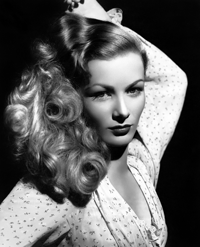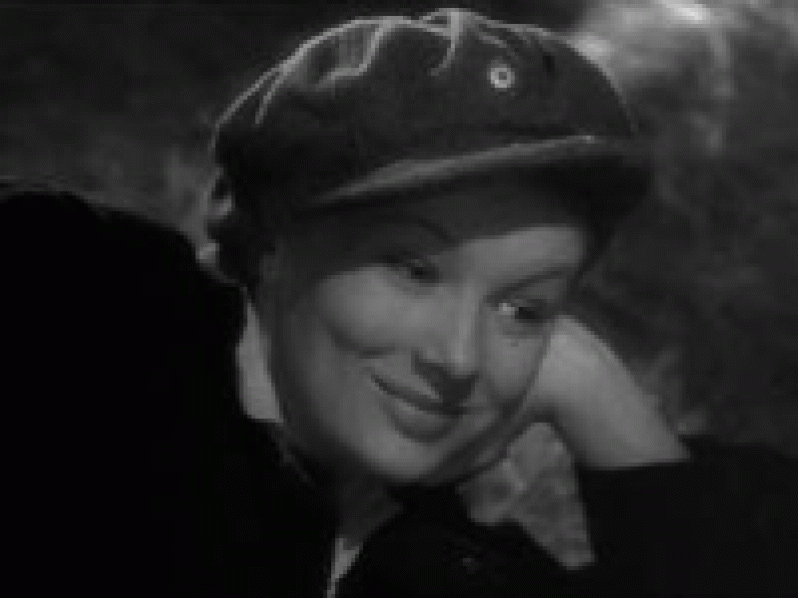LAKE’S roles in films like ‘THIS GUN FOR HIRE’ — taken from the British writer, Graham Greene’s espionage novel of another title — could have been done by many other actresses, but we can be sure they would not have that specific and appropriate tone of voice; that caring yet hip way of listening, or making an outcast man reveal his humane side; or come to believe in and even love a woman whose fiancé is a detective on his tail, and who never becomes his intimate partner.  Similarly, in ‘THE GLASS KEY’, Lake and Ladd are at odds with each other: He is suspicious of her involvement with a crime that implicates her husband-to-be, a political candidate, whose bodyguard he is; while she is repulsed by Ladd’s tough, cold, ungentlemanly ‘don’t-care’ attitude towards her.
Similarly, in ‘THE GLASS KEY’, Lake and Ladd are at odds with each other: He is suspicious of her involvement with a crime that implicates her husband-to-be, a political candidate, whose bodyguard he is; while she is repulsed by Ladd’s tough, cold, ungentlemanly ‘don’t-care’ attitude towards her.
Beneath both their attitudes is a mutual similarity that craves to be confirmed, and this is eventually achieved in this unforgettably beautiful film, as Lake comes to see through the narcissistic flawed privilege of her wealthy father and would-be husband, on whose behalf Ladd is brutally beaten, until Lake realizes she must move away from their corrupting influence, and Ladd from his servile job as their henchman.
Lake and Ladd run away together into a less wealthy and glamorous future after they admit they really have ‘the hots’ for each other, in an ending that sets the imagination racing about the unseen combination of Lake’s ‘fire’ and Ladd’s ‘ice’.
Fashion and fire
‘The Glass Key’, taken from one of Dashiel Hammett’s most stylishly written novels, is one of Lake’s most simmerin g hot roles which hinted at her fashionable and fiery sensual potential. It is in ‘THE BLUE DAHLIA’ that Lake’s role offered some of the human realism and social attitudes which make this a special classic of cinematic art.
g hot roles which hinted at her fashionable and fiery sensual potential. It is in ‘THE BLUE DAHLIA’ that Lake’s role offered some of the human realism and social attitudes which make this a special classic of cinematic art.
Both Ladd and Lake, in this one, have lost their romantic partners, and the circumstances which bring Ladd to Lake’s attention is itself as a result of social upheaval: The 2nd World War, when Ladd is part of some friends who return from the war not only damaged from action, but, in his case, but to find as well that he’s lost his wife to another man, or men, in his absence.
Lake’s wealthy male partner has become involved with Ladd’s wife, and she reaches out to him in sympathy and gradual romantic interest. When Lake sits on a wall in a restaurant beside Ladd, rather than use the chair at the table where he lunches, the entire scene suits her style of conveying care, combined with feminine availability, since her trousers, her posture, her look towards him offer the assets of her figure, and suggest a relaxed style of attractive equality between man and woman.
Attractive roles
The attraction of Lake’s roles for both her female and male film fans, and the professional actresses of today (aged over 50) who build on her style, comes from lake’s individualistic interpretation of ‘acting’. What we see of Lake in her films is much more than what her directors told her to do, since they can only direct physical and emotional ‘theatrics’; not the inner style of her performance.
In ‘SULLIVAN’S TRAVELS’, Lake (as Joel McCrea’s actress side-kick who disguises as a male tramp to accompany him, a famous film director in his idealistic effort to see what is happening across America), rather than propagate false film fantasies for audiences, delivers one of her most unique performances, which criticises glamorous escapism in Hollywood.
Lake’s role in ‘Sullivan’s Travels’ became an early forerunner of beatnik fashion and adventurism from the 1950s onward. Her most negative and rebellious role was in the amazingly realistic Western, ‘RAMROD’, of 1947, directed by her husband, director Andre de Toth, whose powerful Westerns, especially with Randolph Scott, are some of the best in the genre.
In ‘Ramrod’, even though Lake is a ‘femme fatale’ in fierce rebellion against her corrupt manipulative father, she herself becomes manipulative of men to build her independent cattle empire; nevertheless, moments of beautiful care and consideration for her two male romantic partners break through in scenes which seem to be hers alone; not the director’s.
Legend begins
In the 1950s, when Lake and her director husband filed for bankruptcy and separated, Lake, in one of the most interesting episodes of Hollywood history, disappeared from the screen and public life.
When she was discovered almost ten years later by a journalist, working incognito as a barmaid in a New York hotel, perhaps only the public was surprised. Lake herself had no remorse, since all the roles we had seen her act had actually come to influence the strength of her real life now.
If no one else did, she knew what she had achieved on screen, and if no one else could find strength in them, she could. Hollywood, by then, was already in decline from its brilliant earlier decades. But so what? Lake was already a legend for the best new actresses and true film fans, a beautiful screen legend, and legends like hers never fade away.




.jpg)










